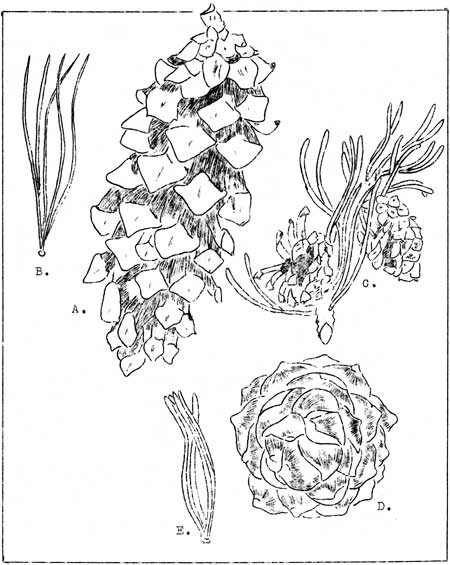WESTERN WHITE PINE
(Pinus monticola)
This tree is quite abundant in many old burns of the
park where it is one of the most important species in the natural
reforestation of such areas. Elsewhere in this area, however, it does
not make up a very large proportion of the stand. While it may be
found from 2000 to 4800 feet in Mt. Rainier National Park it is most
common in the intermediate timber zone from the 3500 to the 4500 foot
levels.
It is a handsome tree, up to 150 feet tall and 2 - 3-1/2 feet
in diameter when mature, with an open, short branched crown. On
mature trees the bark is dark ash-grey, broken up into numerous
small square plates by which it may be readily identified from its
associates, as none of these have a similar bark character. On young
trees, as well as upon the branches of older specimens, the bark is
smooth, thin and light grey. The foliage is a deep blue green in
color and the slender needle, which are 2-4 inches long, are borne five
to a cluster. The cones mature at the end of the second season and are
quite large, being from 6-12 inches long, 2-3 inches. in diameter at
maturity, and very resinous. The wood is light, soft and free of
pitch. It has high technical properties which render it of considerable
value as a commercial timber in areas where it may be cut and utilized.
The western white pine is fairly long lived, attaining an age of
from 200-500 years.
Unfortunately this species is susceptible to the attacks of the white
pine beetle (Dendroctinus monticolae) and the white pine blister rust
(Cronartium ribicola) which have destroyed a considerable amount of this
fine timber in the park. The ravages of the beetle have been controlled
but the work of retarding the inroads of the blister rust has been in
progress since 1931. Since that time a great number of currant and
gooseberry bushes, which act as the alternate host of this introduced
fungus disease, have been eliminated from certain sections of the park
where maintenance of the western white pine is especially desirable. The
lower Stevens Canyon-Cowlitz River area and the "Silver Forest" fall
into that category.
While this species reaches its best development in northern Idaho it
is found throughout a large part of the mountainous section of the
northwest. Its range includes the area from the western slope of
the continental divide in western Montana to the Pacific and along the
Pacific Coast from British Columbia to northern California.
-oOo-

WESTERN WHITE PINE (Pinus monticola). A-Cone (x1).
B-Foliage (x1), illustrating the five needled cluster which is
characteristic.
LODGEPOLE PINE (Pinus contorta).
C-Twig, cones and foliage (x1). Note that needles are borne two to a
cluster in this case.
WHITE-BARKED PINE (Pinus
albicaulis). D-Cone (x1). E-Foliage (x1), illustrating the five
needled cluster which is characteristic.
-oOo-
Descriptions continued...

